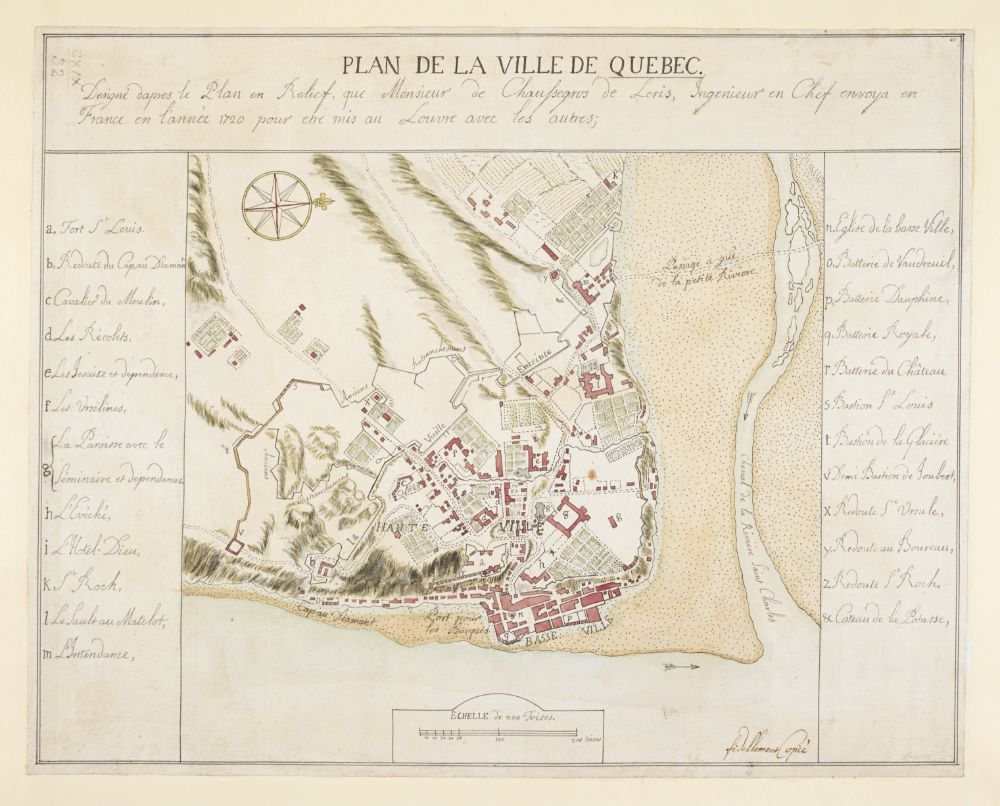bloc_article_content
Quebec, the Capital of New France
Under the French Regime, the city of Quebec was the administrative centre of the colony from 1608 to 1759.
The Exploration of the New World
In the early 16th Century, before Jacques Cartier spent the first winter among the Saint Lawrence Iroquois at Stadaconé (Quebec) in 1535, the French and Basques had been fishing for cod off the coasts of North America and trading for beaver with region’s the Indigenous peoples. Following this, the French made their first attempt to colonize the Saint Lawrence Valley between 1541 and 1543, but this ended in failure.
Even so, fur traders continued to visit the Saint Lawrence River. In 1603, Samuel de Champlain concluded a military alliance with the Indigenous peoples of Tadoussac. At this meeting, they also seemed to agree that the French could inhabit the territory.
The Founding of Quebec
Quebec’s geomorphology made it the keystone of the Saint Lawrence valley. Here, on July 3, 1608, Champlain and 28 men built the first outpost or Abitation. By the time the Company of One Hundred Associates acquired the fur-trading monopoly to finance its colonization policy, the post was occupied by around sixty colonists.
Quebec fell into British hands in 1629, but it was soon granted back to France in 1632. Cardinal Richelieu subsequently ordered that only Roman Catholics could set up home in New France. By 1663, the population of Quebec was estimated at around 600 inhabitants, while, in total, the colony numbered about 3,000 people, mostly men.
As a city, Quebec remained modest. Its position as an administrative and military centre became more apparent with the residence of a Governor from 1636 and the construction of the Chateau St. Louis in 1647. Yet, the clergy remained the best-constituted social body, as can be seen in the founding of the Jesuit college in 1635 as well as the establishment of the École des Ursulines and the Hôtel-Dieu des Hospitalières in 1639. Meanwhile, conflict with the Haudenosaunee Confederacy (Iroquois) between 1641 and 1667 delayed the colony’s demographic and economic development.
The Capital of a Royal Province
In 1663, the council of King Louis XIV introduced a new colonial program that inaugurated New France as a royal province. In Quebec, a Sovereign Council was created to oversee state business.
In 1665, 1,300 soldiers from the Carignan-Salières Regiment arrived in Quebec to fight against the Haudenosaunee. A third of these men then settled permanently in the colony. Most of them were French, but some were Irish, Italian, Swiss or Walloon. The arrival of 725 King’s Daughters between 1663 and 1673 soon reduced the colony’s gender imbalance. This continued effort to populate the colony, along with natural growth, increased the population over the generations. By the second half of the 17th century, Quebec had become a small colonial town.
Meanwhile, the local Indigenous populations had been victims of war and epidemics. Around 1700, there were estimated to be about 9,000 of them living in Canada and Acadia. Nevertheless, it was the military alliances forged between France and these nations that enabled the French to secure their claim to the territory of New France.
A Two-Headed Government
In 1665, the arrival of an Intendant in the capital set the cogs of the colonial administration whirring. Responsible for civil administration, the Intendant oversaw the smooth operation of justice, drafted rules and regulations to ensure public order and inspected the receipts and expenditure of the colonial administration.
As the colony’s military leader, the Governor retained his diplomatic role with the Indigenous peoples and commanded both the regular troops and the militia. Meanwhile, the Sovereign Council maintained a primarily legal function, operating as an appellate court.
The Conquest
The frontiers of New France were continually disputed by the Hudson’s Bay Company in the north and the British colonies in the south. In 1690, Quebec was besieged for the first time by a fleet of 34 ships led from New England by Major General Phips. Governor Frontenac, however, was able to defeat Phips’ men. Two decades later, the wreck of Admiral Walker’s fleet in 1711 forced the British to abandon another planned invasion.
The “Long Peace” between 1713 and 1744 allowed the colony to develop. By the middle of the 17th century, the city of Quebec had around 8,000 inhabitants, while the population of New France had reached about 70,000, a number which also included the populations of the Indigenous mission villages and hundreds of Indigenous and African slaves.
During the Seven Years’ War, the British returned to Quebec, navigating their way upriver and bombarding the capital. On September 18, 1759, five days after the French defeat on the Plains of Abraham, the city of Quebec surrendered. The fall of Montreal on September 8, 1760 sealed the colony’s fate. New France then became a British colony under the Treaty of Paris, signed on February 10, 1763.
Published in may 2021
Réduire l'article ^





